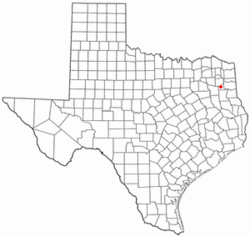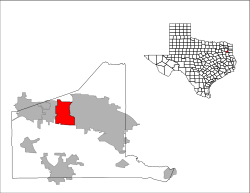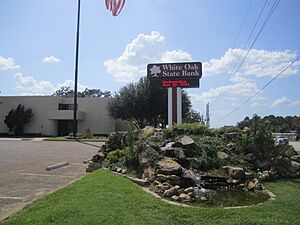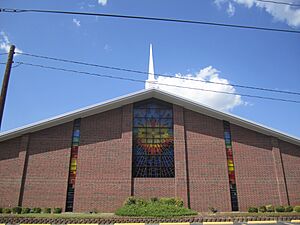White Oak, Texas facts for kids
Quick facts for kids
White Oak, Texas
|
|
|---|---|

White Oak Municipal Building
|
|
| Motto(s):
"Pride, Tradition"
|
|

Location of White Oak, Texas
|
|
 |
|
| Country | United States |
| State | Texas |
| County | Gregg |
| Area | |
| • Total | 9.14 sq mi (23.67 km2) |
| • Land | 9.09 sq mi (23.54 km2) |
| • Water | 0.05 sq mi (0.13 km2) |
| Elevation | 358 ft (109 m) |
| Population
(2020)
|
|
| • Total | 6,225 |
| • Density | 695.49/sq mi (268.54/km2) |
| Time zone | UTC-6 (Central (CST)) |
| • Summer (DST) | UTC-5 (CDT) |
| ZIP code |
75693
|
| Area code(s) | 903, 430 |
| FIPS code | 48-78436 |
| GNIS feature ID | 2412253 |
| Website | City of White Oak, Texas |
White Oak is a city in Gregg County, Texas, United States. It became an official city in 1960. In 2020, about 6,225 people lived there.
Contents
History of White Oak, Texas
In the late 1800s, White Oak was a small community where people mostly farmed. There were also three sawmills because the area had lots of trees. By 1884, about 15 families lived here. Most people worked at the sawmills or farmed near the creeks and rivers.
A small school was built near Hawkins Creek. On Sundays, this school also served as a church. Sadly, the school burned down in 1885. People thought it was set on fire, but no one was ever caught.
A new school was built in 1887. Local landowners, Andrew J. Tuttle and his father-in-law, John Bumpus, gathered people to help build it. Mr. Tuttle's uncle, Pleas Harris, and Kaleb Bumpus gave land near a spring for the new school. Stories say that after the school was built, Tuttle and Bumpus noticed two large White Oak trees on each side of the building. They decided to name the community "White Oak."
The community grew a lot during the oil boom of the 1930s. This was a time when many people moved to Texas because oil was discovered. White Oak kept growing even more after World War II. Finally, in 1960, White Oak officially became a city.
Geography of White Oak
White Oak is located in Texas. The city covers about 9.1 square miles (23.67 square kilometers). Most of this area is land, with only a small part, about 0.1 square miles (0.13 square kilometers), being water.
Population and People of White Oak
The number of people living in White Oak has changed over the years:
| Historical population | |||
|---|---|---|---|
| Census | Pop. | %± | |
| 1960 | 1,250 | — | |
| 1970 | 2,300 | 84.0% | |
| 1980 | 4,415 | 92.0% | |
| 1990 | 5,136 | 16.3% | |
| 2000 | 5,624 | 9.5% | |
| 2010 | 6,469 | 15.0% | |
| 2020 | 6,225 | −3.8% | |
| U.S. Decennial Census | |||
In 2020, the city had 6,225 people. Most people living in White Oak were White (about 81%). Other groups included Black or African American people (about 3%), Native Americans, Asians, and Pacific Islanders. About 9% of the population was Hispanic or Latino.
There were 2,067 households in the city. Many households (about 44.6%) had children under 18 living there. Most households (about 64.7%) were married couples living together. The average household had about 2.81 people.
The average income for a household in White Oak was about $43,802 per year. For families, the average income was about $50,781. About 11.4% of the people in White Oak lived below the poverty line. This included about 12.4% of children under 18.
Education in White Oak
Most of White Oak is part of the White Oak Independent School District. This means students living in these areas go to schools managed by this district. A small part of the city in the southeast belongs to the Pine Tree Independent School District. Also, a very tiny section in the northwest is part of the Gladewater Independent School District.
Before 1966, schools in this area were segregated. This meant Black children and White children went to separate schools. In 1966, this changed, and Black children from nearby Shiloh were allowed to attend White Oak schools. The Shiloh School, which had been open since shortly after the Civil War, closed its doors after this change.
Famous People from White Oak
Many interesting people have come from White Oak, including:
- Mike Barber – A football player who played as a tight end for the Houston Oilers.
- Byron Hunt – Another football player who played for the New York Giants in the early 1980s.
- Sam Hunt – A linebacker for the New England Patriots from 1974 to 1979.
- Max McGee – A wide-receiver who played for Tulane University in the 1950s and later for the Green Bay Packers.
- Kelcy Warren – A very successful businessman who is the chairman and CEO of Energy Transfer Partners.
See also
 In Spanish: White Oak (Texas) para niños
In Spanish: White Oak (Texas) para niños



